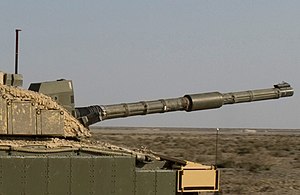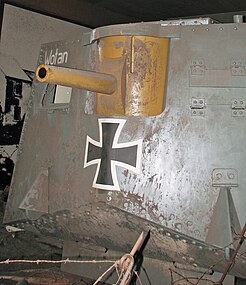Tank gun
This article needs additional citations for verification. (January 2017) |

A tank gun is the main armament of a
As the tank's primary armament, they are almost always employed in a
History
World War I
The first tanks were used to break through trench defences in support of
The early British
The first German tank, the A7V, used British-made 57 mm Maxim-Nordenfelt fortification guns captured from Belgium and Russia, mounted singly at the front.
The early French
-
French Saint-Chamond tank of 1917, with 75 mm gun in nose
-
Replica of German A7V "Wotan" showing 57 mm Maxim-Nordenfelt gun in front
-
BritishMk II tankcaptured by German troops in April 1917, showing long 57 mm naval gun in side sponson
World War II


This thinking remained pervasive into the dawn of World War II, when most tank guns were still modifications of existing artillery pieces, and were expected to primarily be used against unarmored targets.[citation needed] The larger caliber, shorter range artillery mounting did not go away however. Tanks intended specifically for infantry support (the infantry tanks), expected to take out emplacements and infantry concentrations, carried large calibre weapons to fire large high-explosive shells—though these could be quite effective against other vehicles at close ranges. In some designs – for example, M3 Lee, Churchill, Char B1 – the larger bore weapons were mounted within the tank hull while a second gun for use against tanks was fitted in a turret.
However, other strategists saw new roles for tanks in war, and wanted more specifically developed guns tailored to these missions. The ability to destroy enemy tanks was foremost on their minds. To this end, the emerging
World War II saw a leapfrog growth in all areas of military technology. Battlefield experience led to increasingly powerful weapons being adopted. Guns with calibres from 20 mm to 40 mm soon gave way to 50 mm, 75 mm, 85 mm, 88 mm, 90 mm, and 122 mm calibre. In 1939, the standard German panzer had either a 20 mm or 37 mm medium-velocity weapon, but by 1945 long-barrelled 75 mm and 88 mm high-velocity guns were common. The
While high velocity tank guns were effective against other tanks, for the most part British tanks moved to a dual purpose 75 mm gun capable of firing a useful HE shell; later in the war adding 76 mm 17pdr gun armed tanks for better antitank capability.
Many nations devised "
After World War II


By the end of the war the variety in tank designs had narrowed and the concept of the main battle tank emerged. The race to increase caliber slowed, with just slight increases between tank generations. In the West, guns of around 90 mm gave way to the ubiquitous 105 mm Royal Ordnance L7, introduced in 1958. This lasted a long while, with a shift to 120 mm in the late 1970s and early 1980s (the UK changed in the late 1960s with their Chieftain tank). In the East, the 85 mm quickly yielded to the 100 mm and 115 mm U-5TS gun, with the 125 mm caliber now standard. Most of the improvements were instead made in ammunition and fire-control systems.
With


Technology of the guns themselves has had only a few innovations. For decades the guns were almost exclusively rifled, but now most new tanks have smoothbore guns. Rifling in the barrel imparts spin on the projectile to stabilized it, improving ballistic accuracy. The best traditional antitank weapons have been kinetic energy rounds, whose penetrating power and accuracy is greatly decreased with the loss in muzzle velocity at extended range. For longer ranges high-explosive anti-tank rounds are more effective, but accuracy is limited; for extremely long ranges cannon-launched guided projectiles (CLGPs) are considered more accurate.[citation needed]
The use of the autoloader has been a development favoured by some nations and not others. Some countries adopted it as a means to keep the overall size of the tank down. Interest has also been shown as a means to protect the crew by separating them further from the gun and ammunition. For example, an autoloader allows the use of an unmanned turret in the T-14 Armata.
Smoothbore
In the 1960s, smoothbore tank guns were developed by the United States, the Soviet Union, and later by the experimental American-West German MBT-70 joint project.
High-precision smoothbore tank gun barrels were perfected by the US Army's Weapons Laboratory at the Watervliet Arsenal based on a pair of patents by inventor Albert L. de Graffenried.[i] More than 20,000 tank cannons were manufactured by the Watervliet Arsenal for the US Abrams M1A1 tank using de Graffenried's patented high-precision manufacturing inventions.
Based on their experience with the 2A28 Grom gun/missile system of the BMP-1, the Soviets produced the T-64B main battle tank, with an auto-loaded 2A46 125 mm smoothbore high-velocity tank gun, capable of firing APFSDS ammunition as well as ATGMs. Similar guns continue to be used in the latest Russian T-90, Ukrainian T-84, and Serbian M-84AS MBTs.
The German company
Most modern main battle tanks now carry a smoothbore gun. A notable exception are the tanks of the British Army which used the 120 mm
See also
Notes
- ^ US3020786A ELECTRONIC TOOL RUN-OUT INDICATOR FOR USE IN DEEP BORING OPERATIONS, Filed July 20, 1960, and US3,217,568 DEVICE FOR CONTROLLING DEEP BORING OPERATIONS IN A ROTATING OBJECT, Filed May 25, 1962.
References
- ISBN 978-0-7106-0595-5.
External links
- Specification and Armor Penetration Values of Soviet Tank Guns – up to the end of World War II, at the Russian Battlefield (battlefield.ru).



